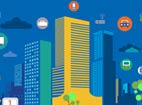Energy is one of the more promising applications for the Internet of Things (IoT) data. By now, you’re no doubt familiar with how utilities have used sensors and smart grids to reduce overall energy costs. A recent Intelligent Utility article shows energy use is just a tactical starting point for how data from smart grids can be leveraged.
The article expands on that by showing how smart grid data can be applied in predictive ways. These “strategic systems” include monitoring transformers to reduce infrastructure costs, reducing energy theft and leaks, and reducing voltage to better manage energy demand and consumption.
The best strategic use cases, though, involve mapping energy usage patterns with external data sets, such as historical weather or demographic data. This would allow utilities to more accurately plan infrastructure and energy supply needs.
I think this shift from tactical to strategic applications of the IoT will be key to realizing its much hyped potential. Too often, though, people talk about the devices and sensors themselves. The take-away here, in my opinion, is that one way to achieve that strategic view is to focus on the data —specifically coupling it with external data sets — rather than the devices.
In some ways, though, tactical has to come first with the IoT because technologists are still figuring out the nuts and bolts of it. If you’re struggling to see how IoT might work in your organization, you might want to check out this clever Periodic Table of IoT.
It’s designed by CB Insights, a data analytics company that has created some press buzz with its Periodic Table of Tech and Periodic Table of Health Care. When I first heard of this, I couldn’t imagine how it’d be useful, since in general, companies don’t add or subtract electrons to change (or maybe they do — I’ll be thinking about that all weekend now).
When I finally studied it, though, I found it surprisingly useful and clever. Basically, it groups and color-codes companies by their IoT niche. It’s truly a visual graphic so you have to see it to get it. Let’s just say if you’re not sure who or how you could use the IoT, you’ll probably find it useful.
Like I said, a lot of work is ahead for IT and the Internet of Things. In addition to identifying the right device partners, you’ll need to think through the data challenges, including how it will change the data center, the API issues for moving the data, and what role cloud will play in IoT implementations.
Loraine Lawson is a veteran technology reporter and blogger. She currently writes the Integration blog for IT Business Edge, which covers all aspects of integration technology, including data governance and best practices. She has also covered IT/Business Alignment and IT Security for IT Business Edge. Before becoming a freelance writer, Lawson worked at TechRepublic as a site editor and writer, covering mobile, IT management, IT security and other technology trends. Previously, she was a webmaster at the Kentucky Transportation Cabinet and a newspaper journalist. Follow Lawson at Google+ and on Twitter.



